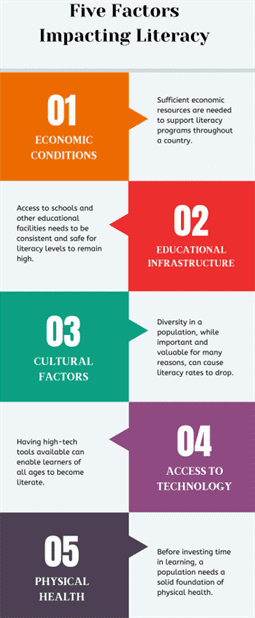
Literacy is fundamental to nearly everything in the modern world. No matter what an individual hopes to accomplish, literacy is going to be a foundational piece of reaching that goal. Without the ability to read, the world is nearly impossible to decode, and opportunities will be few and far between.
This is true on an individual level just as it is true for larger societies. When a society is highly literate, there is tremendous potential held in that population – the sky is the limit for what can be achieved.
That introduction brings us to the key question that will be tackled in this post – what is the status of literacy in America? The United States is considered a global leader in many areas, but does that reputation extend to the literacy of the population as a whole? We’ll dive deep into the matter below to understand what is going on with literacy in the U.S. and how it compares to various populations around the globe.
What Makes a Person Literate?
On a basic level, it’s easy to define the word “literate” – it’s the ability to read and write. If you look a little closer, however, things get a bit trickier. How do you determine what counts as being able to read and write? How many words does one need to know to be literate? How is the testing completed? Soon enough, you wind up with more questions than answers and the whole thing gets a bit murky.
Throughout this post, you’ll see that literacy statistics vary a bit depending on who is doing the testing, what methodology is being used, and where in the world the evaluations are located. We’ll do our best to offer supporting information on the statistics provided, but it’s important not to get too caught up in the details. Despite minor variations in definitions and methods, the overall statistics still paint an important picture regarding how many people are literate and where those people can be found.
Literacy in the United States
Before we can look at how the United States compares to the rest of the world, we have to first understand what literacy looks like within the U.S. borders. Only against that backdrop will comparing American performance to other nations be a worthwhile exercise.
If you would like to come away with one quick stat from this post that will be easy to remember, let it be this one – according to the National Literacy Institute, 79% of adults in the United States are literate as of 2024. That number might look somewhat encouraging at first, as it means that nearly four out of every five adults are considered literate. When viewed from another perspective, however, it’s not so rosy. With 21% of U.S. adults facing some degree of illiteracy, some quick math based on the population of the country shows that around 50 million U.S. adults are illiterate. Looking at the raw number of people who lack basic reading and writing skills highlights the fact that literacy continues to be a very real problem for millions.
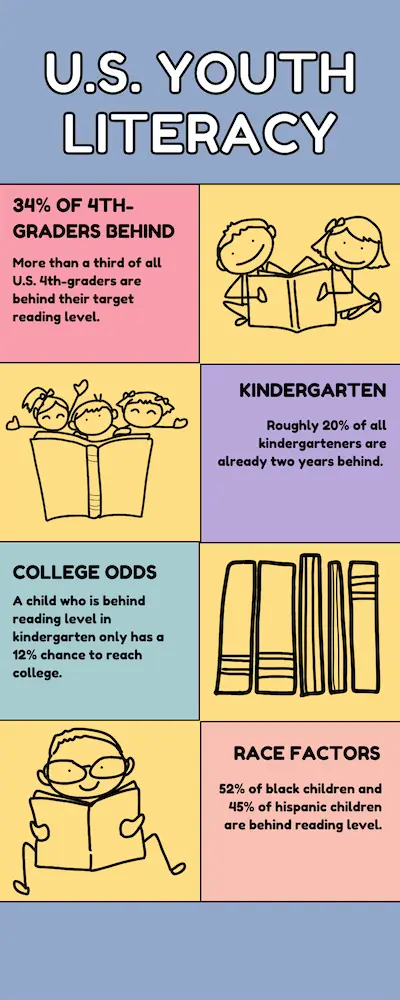
It should be noted that the 79% number seems to be based on a high threshold of literacy. As we have already mentioned, there are different standards that can be used, so the numbers are going to vary from one place to another. At the 79% level, it seems that the standard being applied is Advanced Literacy, at which level individuals are able to read and write at a high level. People with this degree of literacy are able to write detailed documents, understand complex texts, and more. So, this stat does not mean that 21% of the United States adult population cannot read or write at all. It does mean, however, that the individuals who are illiterate by this measure face an uphill battle in many areas of life.
Literacy is not only a problem on the individual level, but it also has an impact on the country as a whole. For example, it is estimated that the low levels of literacy in the U.S. compared to other developed nations come at a staggering cost of more than $2 trillion per year. Improving literacy is an initiative that would not only go a long way toward improving the quality of life of millions but would also help the economic performance of the country.
Literacy Rates in U.S. Youth
The best way to create a literate adult is to create a literate child. While it’s not impossible to become literate later in life, learning comes easier and the opportunities are more available at earlier ages.
It’s important for young people to become literate as early as possible because that ability will set them up for infinitely more opportunities. With reading and writing mastered early on, individuals can start to think about bigger and bigger goals and what they want to accomplish in life. Whether it’s becoming a doctor or a lawyer, starting a new business, creating an organization that serves others, running for public office… whatever it is, those kinds of dreams aren’t possible without first putting the foundation of strong reading and writing skills in place.
With that said, literacy rates in young people are important metrics to monitor. Here are some notable stats to consider on this topic –
– Approximately 34% of fourth-grade students are below the basic reading level for their age, according to the U.S. National Center of Education Statistics.
– According to the Children’s Reading Foundation, 20% of children go into kindergarten already two or more years behind their grade level. 20% more go into kindergarten a year behind their expected skill level.
– Once a student is behind their reading level, they tend to remain behind through the rest of their time in school.
– Also from the Children’s Reading Foundation, a student who is behind when starting kindergarten only has a 12% chance of later attending college.
– National Center of Education Statistics data shows that Black fourth-graders are behind reading level at a rate of 52%, while 45% of Hispanic students of the same age are behind. For white students, the rate is 23%, highlighting the role that race plays in this equation.
The statistics can go on and on, but the message is clear – millions of young people are starting out life at a disadvantage. With so much of their future tied to an ability to read and write competently, allowing young people to fall behind on these fundamental skills is a failing of the system.
Demographic Differences in U.S. Literacy
It’s easy to fall into the trap of looking at the United States as a whole when considering literacy or other important metrics of the society’s health. Unfortunately, the real world isn’t that simple, and there are actually meaningful differences in literacy across the U.S. Some of these differences are geographic while others come down to population demographics and the circumstances faced by each individual. Let’s dive into some statistics in this area to better understand how literacy varies within the U.S. population.
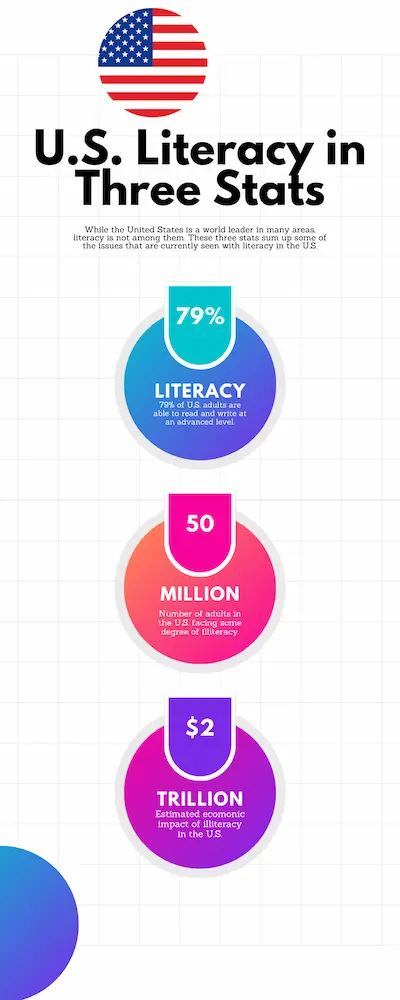
Dramatic Geographic Variations
To look at the role geography plays in literacy in the U.S., we can break things down state-by-state. This is a convenient way to get a clear overall picture of where in the country people are learning to read and write effectively. In this section, the information comes from Data Pandas, which offers a detailed map and literacy rates for every state in the country. The overall rate of literacy in this set of data is 88.3% for the U.S., meaning it is using a lower standard to measure what is literate. This is likely a level of functional literacy, where people are able to read and write well enough to get through their day and complete tasks like filling out forms and writing basic messages.
From the baseline nationwide average of 88.3%, we can see that there is significant variation in literacy based on location. First, a list of the most literate states in the Union –
– New Hampshire – 94.2%
– Minnesota – 94%
– North Dakota – 93.7%
– Vermont – 93.4%
– South Dakota – 93%
As you can see, the most literate states in the country are all in the north. If we were to continue that list, the pattern would proceed – other states above the 90% mark include Wisconsin, Maine, Montana, Washington, Iowa, Michigan, and Indiana.
If the most literate states are in the north, it obviously follows that the states at the bottom of the rankings are going to be in the south. Here are the five states ranking lowest in literacy –
– California – 76.9%
– New York – 77.9%
– Florida – 80.3%
– Texas – 81.0%
– New Jersey – 83.1%
While the pattern does continue for the most part, there are obviously a couple of northern states – New York and New Jersey – mixed in at the bottom of the list. Were we to continue on, other states that are below 85% literacy include Georgia, New Mexico, Louisiana, and Mississippi.
The Role of Language
The United States is an English-speaking country, and as a result, the literacy of the population is gauged by its ability to read and write English. Of course, not everyone in this country starts out with English as their first language. Trying to become literate in English after starting life using a different language is a notable challenge.
The term English language learners is used in schools to describe students who have limited proficiency in the language. It’s no surprise that some of those states listed above as having a lower level of adult literacy also have a high percentage of English language learners in their schools. For example, according to Pew Research, California has ELL students making up 21% of the student population, a rate that is more than double the national average. This diversity in the classroom, and in the state as a whole, goes a long way toward explaining the literacy rate in adults.

What It Means to Be Illiterate
When looking at aggregated numbers on literacy, it’s easy to lose track of the individual people behind these numbers. These stats are more than just abstractions – they represent real people who are trying to live their best lives and may be struggling to achieve their goals as a result of their limited ability to read and write.
Some statistics from Cross River Therapy highlight just how serious this situation is for people who are illiterate in the United States. Some of the concerning numbers include the following –
– Roughly half of adults who have low literacy levels are unemployed
– Two-thirds of 4th-grade students who are unable to read will wind up in jail or on welfare
– 1 out of 6 children who don’t read by third grade will not graduate high school on time
– 43% of adults with low literacy live in poverty
The stakes could hardly be any higher when it comes to literacy. Perhaps more than any other single factor, the opportunity to live a comfortable and secure life in the United States is directly tied to an ability to read and write. Without that ability, everything becomes much harder to achieve, if not impossible.
The Relationship Between Crime Rates and Literacy
The relationship between literacy and crime is a complex and well-documented issue, revealing significant social and economic implications. Low literacy levels have been consistently associated with higher rates of incarceration and criminal behavior. According to the National Assessment of Adult Literacy (NAAL), a substantial percentage of inmates possess lower literacy levels compared to the general population. Specifically, the Literacy Project Foundation reports that over 60% of adults in the U.S. prison system read at or below the fourth-grade level. This stark contrast highlights the critical role that literacy plays in preventing criminal activity and facilitating rehabilitation
Educational attainment, closely linked to literacy, has been shown to have a direct impact on crime rates. Individuals with higher levels of education are less likely to engage in criminal activities, as education opens up better economic opportunities and fosters essential social skills. A study by Lance Lochner and Enrico Moretti (2004) provides compelling evidence for this link, estimating that a 1% increase in the high school graduation rate could save the United States approximately $1.4 billion annually in reduced crime costs. This statistic underscores the economic benefits of investing in education as a means to reduce crime.
Youth literacy is particularly crucial in this context, as early literacy intervention can significantly mitigate juvenile delinquency. Research indicates that young people with poor reading skills are more prone to engaging in delinquent behavior. Programs that focus on improving literacy from an early age have shown promising results in reducing juvenile crime rates. For example, studies reveal that youths who participate in literacy programs are less likely to enter the criminal justice system, highlighting the importance of early educational support in preventing future criminal behavior.
Recidivism, or the tendency of previously incarcerated individuals to re-offend, is another area where literacy plays a pivotal role. Correctional education programs that include literacy training have been proven to reduce recidivism rates significantly. A meta-analysis conducted by the RAND Corporation found that inmates who participated in educational programs, including literacy courses, were 43% less likely to return to prison. This statistic demonstrates the transformative potential of education in breaking the cycle of crime and aiding the reintegration of former inmates into society.
Socioeconomic factors are intricately linked to both literacy and crime. Individuals from lower socioeconomic backgrounds often have limited access to quality education, resulting in lower literacy levels and higher crime rates. This cycle perpetuates social inequality and economic disparity. The National Center for Education Statistics (NCES) reports that 70% of inmates in U.S. prisons cannot read above a fourth-grade level, further illustrating the connection between poor literacy and criminal activity. Addressing these socioeconomic disparities through comprehensive educational reforms and literacy programs can lead to a substantial reduction in crime rates, enhancing the overall well-being of society.
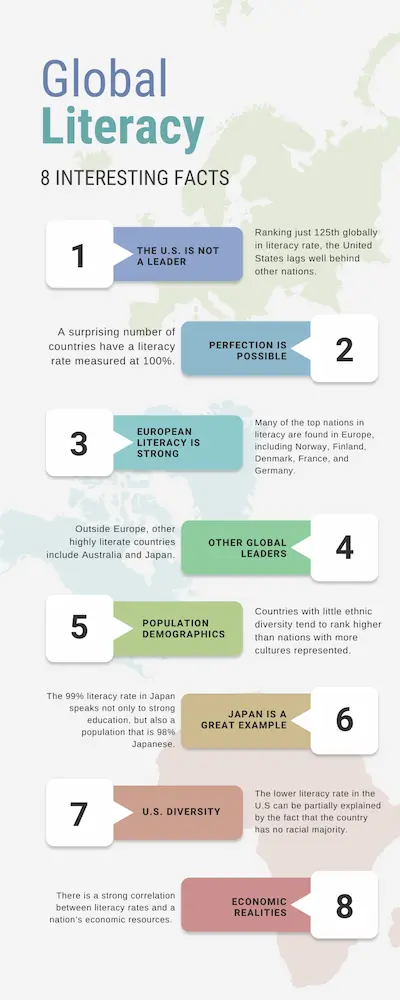
U.S. Literacy Compared to the Rest of the World
With a picture of literacy in the U.S. in place, let’s zoom out and take a look at how Americans’ ability to read and write compares to the rest of the globe. With a reputation as a world leader in many areas, it would be tempting to think that the U.S. is going to come in at the top of this list, as well – but that’s not how it shakes out.
According to data from WorldAtlas, the United States has a literacy rate of 86% (which aligns pretty well with the numbers from DataPandas we used earlier). That 86% rate only places the United States 125th on the list of all nations, well behind many other developed countries.
Rather than comparing the United States to all countries, which isn’t really a fair comparison for many different reasons – many of those economic – it’s more useful to look at how the U.S. compares to the other countries in the Organization for Economic Cooperation and Development. There are 35 countries in the organization, and despite spending significantly more per student on education, the U.S. ranks just 31st in standardized testing performance (which is not the same as literacy but is another measure of educational progress).
In a moment, we will get into a significant factor that plays a role in U.S. literacy and partially explains why it is so far behind so many other countries. With that said, it’s already clear that the U.S. is not a leader in this area and that much work remains to be done.
The Best of the Best
Impressively, there are many countries on the literacy rankings that have achieved a mark of 99% – 100%. Many of these, but not all, are in Europe. Some of the top performers in global literacy include Norway, Finland, Russia, Ukraine, Denmark, Australia, France, Germany, Japan, Netherlands, Sweden, and Switzerland.
Strong educational systems in these countries make it possible for virtually everyone to receive the education needed to achieve a functional level of literacy by the time they reach adulthood.
These countries should be commended for their commitment to literacy and their achievement in this area, but there is an important factor to remember – one that goes back to our previous discussion about varied literacy within the United States. Many of the nations at or near the top of the literacy list are those with very little ethnic diversity within their borders. With a population made up largely of people who were born and raised in the country – and who have only been exposed to one language – it becomes much easier to make sure everyone can read and write.
Japan is an excellent example of this concept. Coming in at 99% literacy, this is a nation that scores extremely well in not only literacy but also a number of other educational metrics. Clearly, the country has a strong educational system in place and does a great job of giving its people opportunities to learn and grow. At the same time, according to Diversity Abroad, Japan as a country has over 98% of its population as Japanese.
This stands in stark contrast to the melting pot that is the United States. In the U.S., there isn’t a single majority racial or ethnic group, as non-Hispanic whites now make up less than half of the population. That doesn’t mean everyone else from all other ethnic categories is learning English as a second language, but it does mean that this far more diverse population has a large share of people who are not speaking just one language throughout their lives.
The picture is much the same with many of the other countries at the top of the literacy rankings. Ethnic diversity, or a lack thereof, does not entirely explain the literacy levels in various countries, but it does play a significant role and is a factor that should be heavily weighed when looking at the data.
Factors That Impact Literacy Globally
Approaching a topic as important as literacy requires an understanding of what it is that drives literacy rates up or down. There are many factors at play here, and it’s far more complicated than just pointing to educational policies – although those do play a role. Let’s go through a few of the factors that impact how many people can read and write within the U.S. and around the globe.
– Economic conditions. It could easily be argued that this is the biggest one of all. When economic resources are available, it’s far more likely that people are going to be educated and become literate. Looking at the bottom of the global literacy rankings will reveal that some of the poorest nations are those with the lowest rates of literacy. This is a theme that is repeated within the United States, as some of the states with the lowest rates are also those with the least financial resources, as we discussed previously.
– Educational infrastructure. Regular, safe access to schools and other educational institutions is a big element in this discussion, as well. Countries that rank low in terms of per capita income and other measures don’t tend to have the resources available to create accessible education throughout the nation, especially in rural areas. As this map shows, the countries with low educational levels tend to be those that also have low GDPs, such as many African nations.
– Cultural factors. This is been a major theme throughout this post. Countries with diverse populations tend to struggle with overall literacy rates due to the language barriers and other cultural factors at play.
– Government policies. It’s important for government policies to step in and promote opportunities for groups that have traditionally been marginalized. That’s often the case for girls and women who need opportunities to access education, as well as various racial groups in different parts of the world. Strong policy that promotes equality in education helps to raise overall literacy rates.
– Access to technology. In the modern world, technology plays a major role in what literacy looks like and how it is achieved. Having the tools available to utilize things like e-learning platforms and educational apps can not only promote literacy in young people, but can also help older learners to catch up and become literate later in life.
– Physical health. Finally, the physical health of a population is an important factor in learning and literacy. Without consistent health as a background for education, it becomes difficult for individuals who study consistently and stay on track for adult literacy. This is seen in parts of the United States with lower levels of physical health just as it is seen around the world.
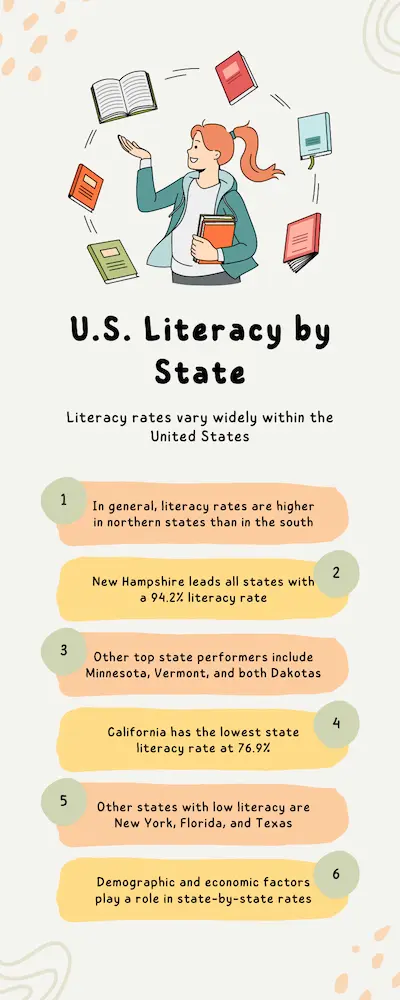
The Impact of Literacy on a Culture
We have already talked some in this post about the economic impact of literacy. When a society is highly literate, that plays to the benefit of the economy as a whole, since a higher percentage of the population is able to contribute to the workforce in a meaningful way. The emphasis on literacy has only grown in recent generations as knowledge work has become more and more prevalent. Nations that lead the way economically tend to be those with a highly educated, knowledgeable workforce with the technical skills needed to drive innovation.
But the value of literacy for a culture doesn’t end at the economy. There are many other benefits to be noted, and once you consider how literacy plays into other cultural factors, it’s easy to see why it’s so important and why some parts of the world struggle to break free from generations-old struggles.
– Social empowerment. It’s difficult for people to be actively engaged and involved in their communities when they are not fully literate. Adults who lack basic literacy are far more likely to be taken advantage of by bad actors who are willing to exploit their lower level of education. This might mean violating their rights for economic gain, as one example.
– Political activism. This is a major part of the harm that can be done by low literacy levels. A democracy is reliant on the population as a whole being literate and able to make its collective voice heard. Without widespread literacy, the population will struggle to take part in the political process, and it will be easier for propaganda and misinformation to spread rapidly. This is commonly seen in underdeveloped countries where governmental corruption is rampant.
– Gender inequality. We saw earlier how there is a notable divide in some parts of the world between male and female literacy. This is a major factor in the struggle for women’s rights that is seen in places around the globe. When women aren’t given access to education and aren’t provided with the opportunity to become literate, they will always be playing an unfair game and will inevitably fall short of their potential and be secondary to males in those societies. While there is a long way to go on literacy equality, this chart from Statista shows that things are getting better.
From Every Perspective, Literacy Is Critical
Attempting to sum up a post like this is a bit tricky. We have covered a lot of ground above, and as you have seen, literacy in the United States as compared to the rest of the world is a bit of a mixed bag. Certainly, literacy in the U.S. ranks among the global leaders in many categories, but it might not be as strong as one would expect given the economic advantages at play. Making improvements moving forward will likely take a renewed focus on literacy from governmental agencies with the resources available to create new programs and reach the people most at-risk in this area.
Of course, when you zoom out, it’s obvious that the United States is in a better position on literacy than many other nations. There are opportunities throughout the country for people to become literate and improve their outlook in life, regardless of gender, race, or economic status. The educational system that builds reading and writing skills could be stronger in order to line up with other developed nations, but the stats show that the large majority in the U.S. are literate and hopefully those numbers will only continue to rise moving forward.
Free Reading Resources To Help You
Reading Duck offers a treasure trove of free reading resources designed to make learning fun and effective for kids. Our site provides interactive phonics lessons, decodable books, printable worksheets, and engaging activities that help young readers build confidence and fluency. Whether your child is just starting out or needs extra practice, our carefully structured materials support systematic reading development in a playful, stress-free way. Plus, everything is completely free-no sign-ups or hidden fees-so parents and educators can easily access high-quality literacy tools anytime. We were recently featured on EDGEucating as a key reading resource.
